This post may contain affiliate links. Please read our disclosure policy.
Cantonese chow mein is a perfect everyday meal for home cooks! Made with simple Chinese pantry staples, it’s budget-friendly, quick to make, and boasts delicious savory notes and crispy textures. Hong Kong-style chow mein is infused with dark and light soy sauce for a rich, umami flavor.
Follow my simple tips to make authentic, restaurant-quality Hong Kong-style crispy egg noodles at home! For another authentic chow mein recipe, try my House Special Chow Mein.
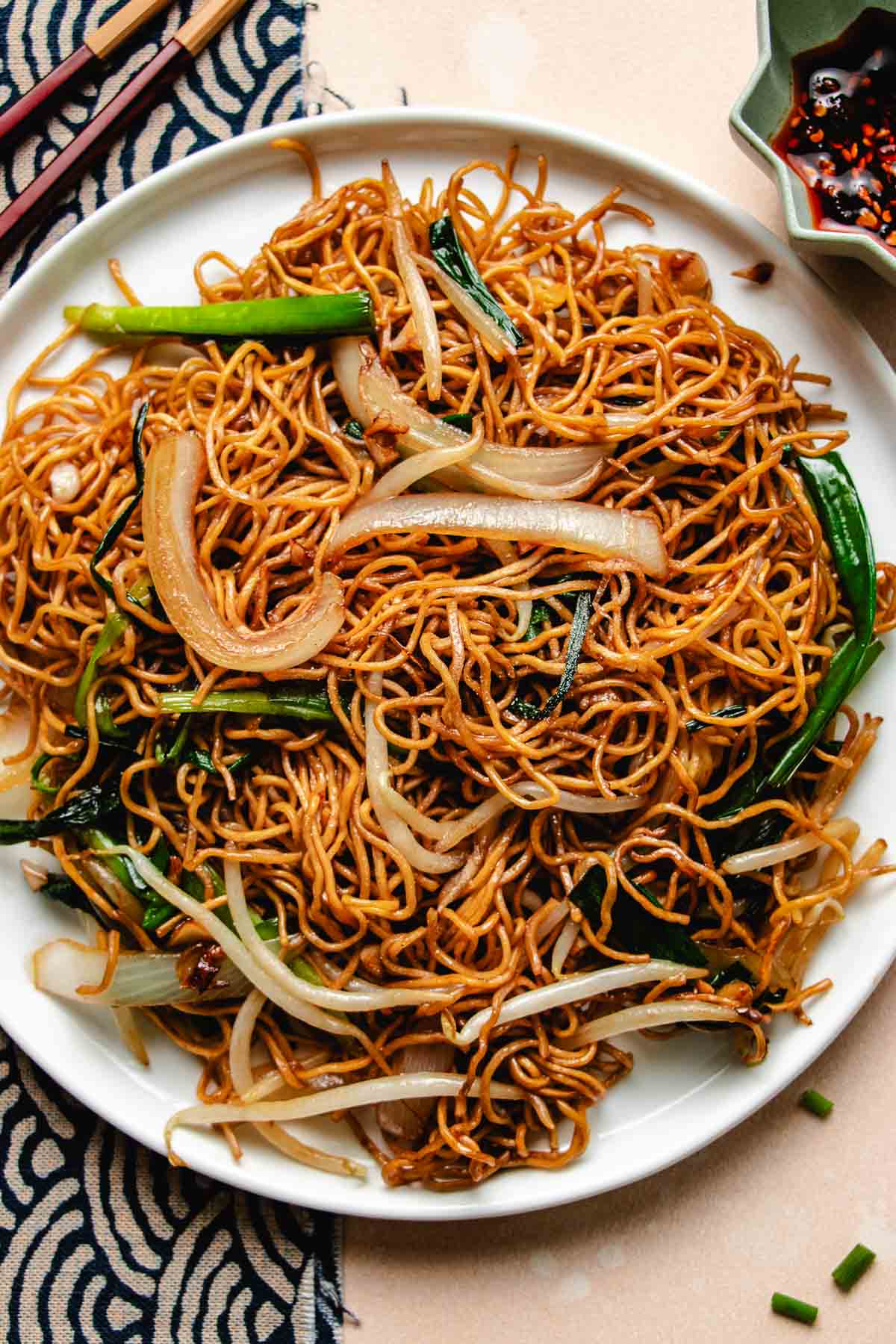
Table of Contents
What is Cantonese chow mein noodles?
Cantonese-style chow mein is a delicious dish made with crispy pan-fried chow mein noodles. These aren’t just any noodles; they’re thin, crinkly Chinese egg noodles that get a nice steam or a quick hot water blanch before hitting the pan. Thin chow mein noodles crisp up nicely for this dish.
What makes these Cantonese-style pan-fried noodles stand out is its sauce—a savory and sweet mix that brings all the flavors together. It’s often called “soy sauce chow mein” because the soy sauce shines here, giving the noodles their signature taste.
The recipe keeps things simple with just a few ingredients, usually skipping meat to let the soy sauce be the star of the show. The simplicity of this Chinese noodle dish makes it fantastic for beginners who are just starting to explore the world of chow mein noodles.
And guess what? Cantonese noodles are often served with dim sum, making them a perfect addition to a feast of small dishes. So, if you’re looking to dive into cooking with chow mein noodles or just want to enjoy a classic, these Asian crispy noodles are a great place to start.
Ingredients
These easy Hong Kong style fried noodles, aka Cantonese pan-fried chow mein, come together quickly using pantry staple ingredients. For this recipe, I use fresh unsteamed chow mein, often labeled as Hong Kong-style crispy egg noodles, that require a quick 30-second hot water blanch.

Noodle stir fry:
- Yellow onion and garlic cloves: These are must-haves for the flavor foundation of this dish.
- Garlic chives: Or substitute scallions, spring onions, or green onions. Dice them into sections.
- Bean sprouts: Add freshness and a refreshing crunch to the dish.
- Thin chow mein noodles: I used fresh, uncooked chow mein noodles for this dish. See the substitutions below or our guide to types of Chinese noodles for more alternatives, including gluten-free options.
- Avocado oil: Or another neutral-flavored oil.
- Coarse sea salt
- Ground white pepper: Use a dash of white pepper for an authentic Chinese takeaway flavor. Black pepper is a good substitute.
Chow mein sauce:
- Light soy sauce: The mix of dark and light soy sauce is a classic combination for this dish. You can also substitute with coconut aminos.
- Dark soy sauce: Dark soy gives a rich color to the sauce. Or substitute with coconut aminos.
- Oyster sauce: Adds depth of savory flavor to the sauce. You can use store-bought or try my homemade vegetarian oyster sauce.
- Toasted sesame oil
- Coconut brown sugar: Or use Keto sugar.
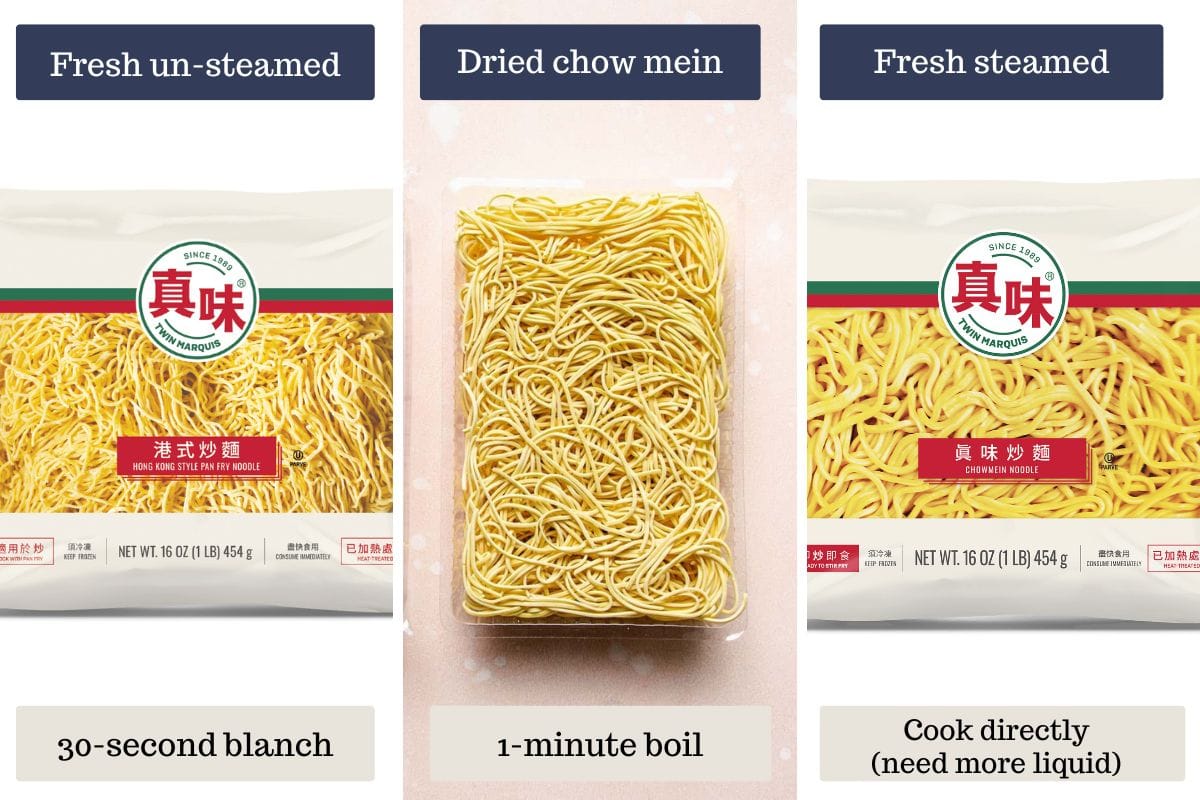
Tip 1: If using fresh steamed chow mein noodles, you can pan-fry them directly. Add a bit of water (about ¼ cup) if needed to avoid dryness, ensuring they steam nicely with the sauce.
Tip 2: If using dried chow mein noodles: They look like instant ramen packets, boil them for 1 minute less than suggested on the package for an al dente texture. After draining, spread them out, toss them with oil, and they’re ready to stir-fry. See our House special chow mein for an example.
Substitutions and variations
- Add veggies: For added color, crunch, and nutrients, add julienned carrots, diced bok choy, sliced fresh or dried shiitake mushrooms, baby corn, celery, ginger, or cabbage.
- Gluten-free seasonings: Use gluten-free Chinese pantry staples like tamari, coconut aminos (paleo), gluten-free light and dark soy sauces, and gluten-free oyster sauce as needed.
- Gluten-free noodles: Gluten-free thin spaghetti noodles, vermicelli pasta, or rice vermicelli (aka mei fun) are good options. They won’t be as crips but won’t affect the flavor.
- Low-carb noodles: Use shirataki noodles or spiralized vegetable noodles.
- Thicker noodles: Try Cantonese lo mein noodles or war mein noodles. Both are slightly thicker and firmer, so they won’t be as crisp as skinny Chinese chow mein with egg noodles.
- Add proteins: Pork, chicken, beef, or seafood (shrimp, squid, scallops) are great additions to this dish. See my pork stir fry marinade, velvet chicken, and beef stir fry marinade for tips.
How to make Hong Kong style chow mein
Making Hong Kong style noodles or crispy soy sauce chow mein at home is so easy and fast! Follow my simple steps to achieve the perfect chow mein crispy noodles every time.

- Prep the noodles: Follow the instructions for the type of Cantonese-style crispy noodles you’re using to cook them to al dente. Drain excess water, coat lightly in oil, and spread them out in a single layer to dry.
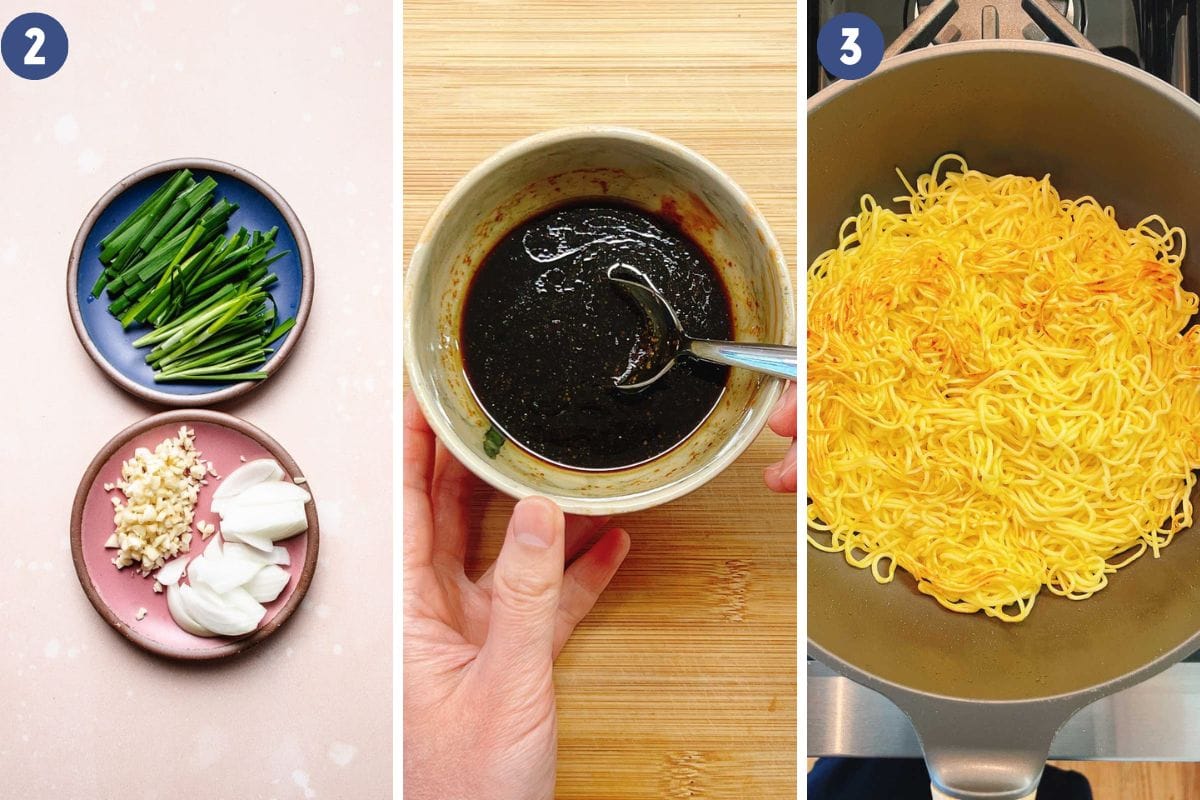
- Prepare aromatics and sauce: Prepare the onion, garlic, garlic chive, and bean sprouts. Combine the chow mein sauce in a bowl.
- Pan-fry the noodles: Add the noodles to a hot wok or pan with oil and pan-fry over medium-high heat for 2-3 minutes. Flip and separate noodles to ensure they crisp up evenly.
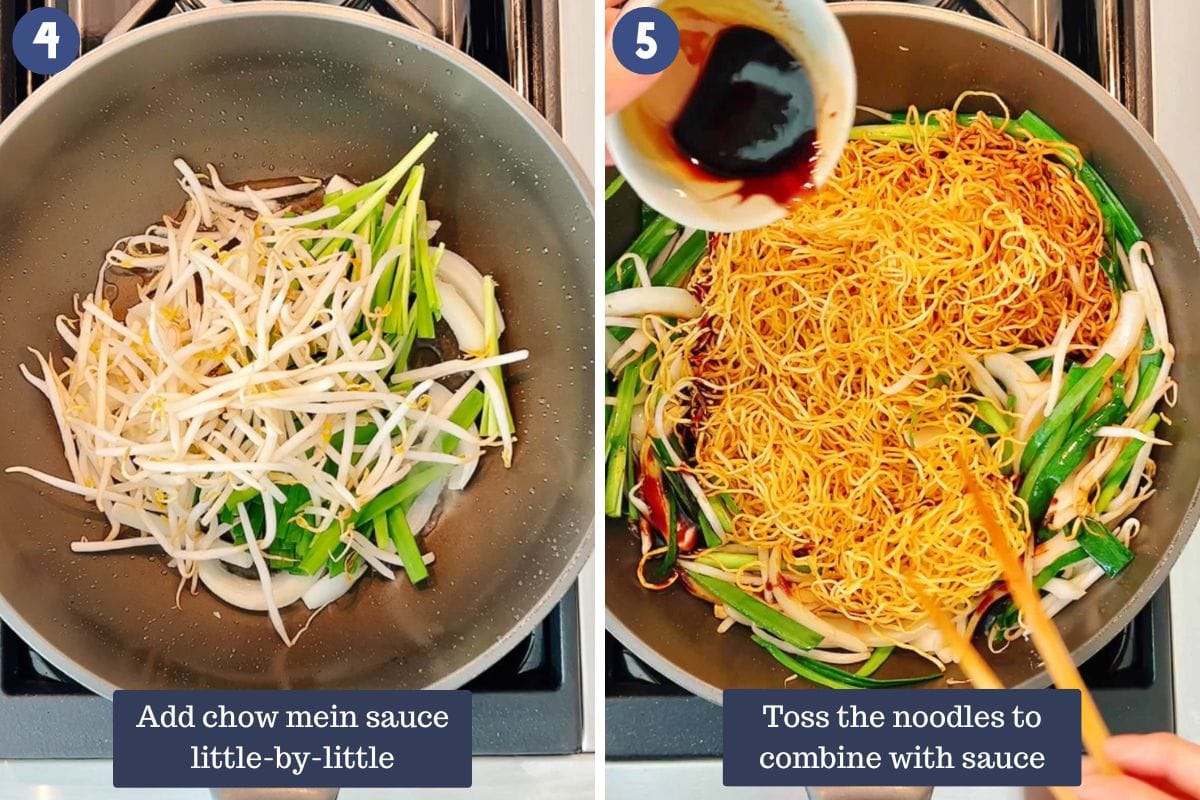
- Saute the aromatics: Remove the noodles from the pan and stir-fry the garlic, onion, chive, and bean sprouts with salt until fragrant.
- Stir in the sauce: Return the noodles to the pan and slowly pour in the chow mein sauce mixture. Stir well to evenly coat the noodles and veggies in the pan.
- Serve: Transfer to a large serving plate. Season with a small dash of white pepper. Serve hot.
Tips for crunchy chow mein noodles
To make crunchy Cantonese pan-fried noodles, start by using minimal ingredients to keep the flavors and textures balanced. Here’s how to ensure your chow mein Canton style comes out perfectly crispy:
- Quick blanching: For fresh chow mein noodles, blanch the noodles in hot water for 30 seconds, then let them cool down and dry. This step is crucial for getting rid of excess moisture.
- Keep them dry: Spread the noodles on a large plate to air out and reduce moisture as much as possible.
- Single layer: When frying, use a large (12-inch or bigger) non-stick pan or a well-seasoned wok. Lay the noodles in a single layer and let them crisp up without stirring too much.
- Restaurant flavor: Achieving the wok hei flavor, which adds a smoky restaurant-like deliciousness, requires the right timing and keeping your cookware at the perfect temperature. This ensures each strand of noodle is crispy, well-seasoned, and delightfully chewy.
How to make ahead, store, and reheat
These crispy Cantonese noodles are best eaten fresh, so I recommend cooking them as needed. It’s a fast and easy dish, but if you want to do a bit of prep in advance, you can dice the aromatics and make the sauce mixture a day ahead of time.
- Make-ahead: Dice the aromatics and mix the chow mein sauce recipe a day in advance.
- Storage: Once cooked, store leftovers in an airtight container in the fridge for up to 4 days.
- Reheat: Microwave on medium for 1 minute until warmed through or stir fry on the stovetop over medium heat. Add 1-2 tbsp water and cover the pan to help “steam” the noodles.
What to serve with Cantonese style chow mein
Cantonese or Hong Kong style chow mein is a simple and affordable Chinese takeout classic! It is traditionally served with dim sum, a Chinese meal of small plates or dishes. Here are some of my favorite pairings to turn these Cantonese pan fried noodles into a family-style feast.
- Dumplings: Start things off with my Keto dim sum featuring juicy meatballs wrapped in cabbage leaves or these crispy gluten-free rice paper dumplings.
- Veggie dishes: Serve with a simple bok choy stir fry, my garlicky Chinese broccoli stir fry, savory Chinese broccoli with oyster sauce, or this super fresh Bean sprouts stir fry.
- Protein dishes: For a balanced meal, add my Paleo beef and broccoli or this Oyster sauce chicken stir fry with shitake and snow pea leaves to the mix.
- Soups: You can’t go wrong with this nourishing pork rib soup with daikon or my authentic wonton egg drop soup with silky wontons and egg ribbons.
Tips for success
- Selecting and Preparing Chow Mein Noodles: Choose between fresh steamed, fresh uncooked, or dried chow mein noodles, with fresh being preferred for optimal texture. Follow package instructions for pre-treatment:
- Freshly steamed noodles can go directly into the pan.
- Fresh uncooked noodles may need blanching or steaming to soften.
- Dried noodles should be boiled but kept al dente.
- Quick Hot Water Blanching: Aim for al dente noodles with a 30-second blanch in hot water. Steaming is another option, but it’s more time-consuming.
- Dry Noodles Thoroughly: Drain well and then spread the noodles on a sheet pan or pat them dry with a towel. This step is crucial for achieving crispy noodles when pan-frying.
- Use a Large Non-Stick Pan or Wok: A spacious non-stick pan or wok is essential for even cooking and preventing sticking. It allows for better movement and heat distribution.
- Avoid Overcrowding the Pan: Cook Hong Kong crispy noodles in batches if necessary. Overcrowding prevents the noodles from crisping up properly.
- Control the Heat: Keep the stove on medium to medium-high heat. The goal is to crisp the noodles to a light golden brown without burning them.
- Keep Ingredients Simple: Focus on the quality of your ingredients. A few well-chosen items can bring out the best in your Cantonese style chow mein.
- Authentic Chow Mein Sauce: Combine light and dark soy sauces, oyster sauce, sesame oil, and a touch of sugar. Gradually pour in the sauce while tossing the noodles for even coverage.
- Achieve Wok Hei at Home: For that unique smoky flavor found in restaurants, pay attention to the cookware temperature and timing. Don’t rush the cooking process; let the noodles and ingredients char slightly to enhance their flavor.
FAQs
Cantonese-style chow mein features crispy, pan-fried noodles topped with a savory sauce, often served with vegetables and sometimes meat. It’s known for its texture and flavorful simplicity. This dish is also referred to as Hong Kong style crispy noodles.
Cantonese or Hong Kong chow mein noodles are crispy and pan-fried, while lo mein noodles are boiled and then tossed with sauce, resulting in a softer texture stir fry.
Chow mein refers to stir-fried noodles that can vary in texture, but Hong Kong-style chow mein is known for its crispy noodles, often stir-fried and then topped with a savory sauce or a thick gravy with meat or seafood.
The sauce in chow mein is typically made of regular soy sauce and dark soy sauces, oyster sauce, sesame oil, and a bit of sugar, creating a rich, savory, and slightly sweet flavor.
More Cantonese pan fried noodles you might like
If you love this crispy chow mein dish, be sure to give my other Cantonese noodle recipes a try, too. They are easy, delicious, healthy, and affordable, so you can’t go wrong!
- Keto chicken lo mein is a low-carb option with loads of veggies and shitake mushrooms.
- Cantonese beef chow mein is a low-carb Paleo dish with spiralized sweet potato noodles.
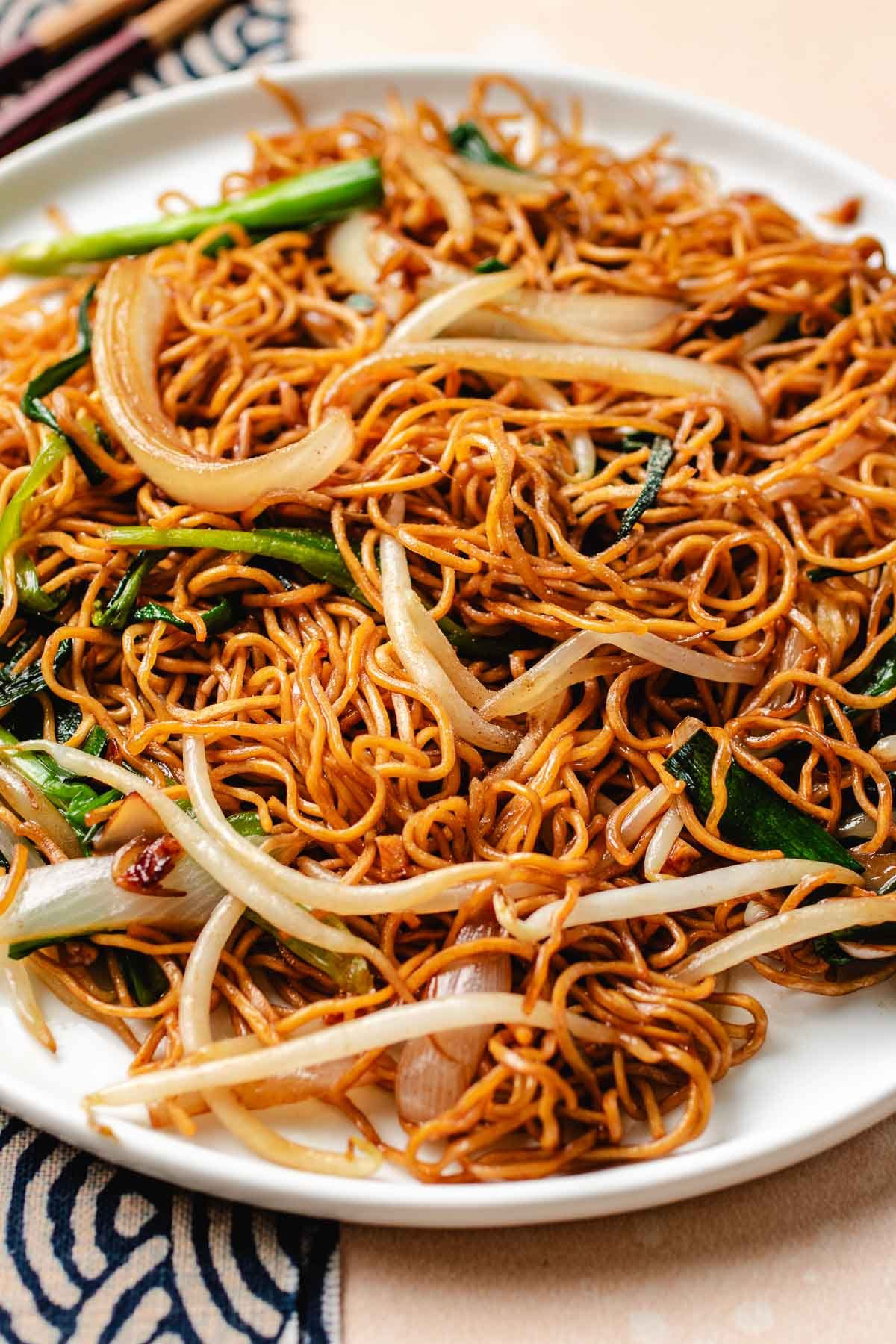
Cantonese chow mein recipe
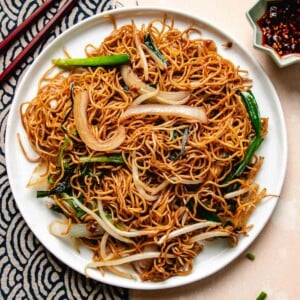
Video
Ingredients
For the noodles:
- 3 oz. yellow onion sliced, half of one small
- 0.8 oz garlic finely minced, 4 large
- 1.5 oz garlic chives or 3 bulb scallions, diced to 2.5-inch sections
- 3.6 oz. bean sprouts about 1.5 cups
- 6 oz. Chow mein noodles or gluten free thin spaghetti noodles
- 2.5 tbsp avocado oil divided
- ¼ tsp coarse sea salt
- ⅛ tsp ground white pepper or black pepper
For the chow mein sauce:
- 1 tbsp light soy sauce
- 1 tbsp dark soy sauce
- 1 tbsp Oyster sauce or homemade Vegetarian oyster sauce
- 2 tsp toasted sesame oil plus more for garnish
- 1 tsp coconut brown sugar or keto sugar
Instructions
For the chow mein noodles:
- Bring a pot of water to boil, use your hands to gently toss and separate the strands as you add the noodles in. Toss the noodles for 30 seconds, using a pair of chopsticks, then drain the noodles and don’t rinse. The noodles aren’t fully cooked and should still feel quite firm and not too sticky.
- Shake off the excess water and spread them out over a large sheet pan or plate. They are ready for stir frying.
- Shake off the excess water and spread them out over a large sheet pan or plate. Toss the noodles with 2 tsp oil. Keep the noodles dry so it’s easier to crisp them up in the pan. Set aside to cool down.
Prepare aromatics and sauce:
- Prepare the onion, garlic, garlic chive, and bean sprouts.
- Combine the chow mein sauce in a bowl.
To crisp up the noodles:
- Add 1 tbsp oil to a large well-heated non-stick pan or wok. When it feels quite warm, add the noodles. Spread them out into a single layer. Turn heat up to medium high and pan fry the noodles without disturbing for 2 minutes. The bottom will crisp up. Then use a spatula to flip the noodles. Add 0.5 tbsp oil along the edge of the pan so that the flip side can crisp up as well. Fry the noodles without disturbing for 1 minute.
- Then use a pair of chopsticks to stir and toss to loosen the noodles a bit. The noodle texture should be crisp but not burnt. When you shake the pan, you should hear a crisp sizzle sound. Transfer them out of the pan over a large serving plate.
Saute the aromatics:
- Use the same pan, add another 0.5 tbsp oil. Add the garlic, onion, chive, and bean sprouts. Season with ¼ tsp salt. Saute for 1 minute over medium to medium-high heat.
Add chow mein sauce:
- Return the noodles to the pan. Stir the sauce one more time then with one hand stirring the noodles and another hand drizzle in the chow mein sauce, little-by-little until all the sauce is poured-in, about 1 minute then turn off the heat.
To serve:
- Transfer to a large serving plate. Season with a small dash of white pepper. Serve hot.
Notes
- To make a larger quantity, you can double the recipe, using 12 oz of chow mein noodles BUT I recommend you cook only 6 oz of noodles at once so that the noodles are crisp up and seasoned evenly. A larger quantity is harder to manage as chow mein noodles are tangled together.
- If using dry chow mein noodles (looks like instant ramen noodles): Cook them for 1 minute less than the package suggests to keep them al dente. After boiling, drain, spread out on a plate, and toss with a bit of oil to keep them dry before stir-frying.
- If using fresh precooked chow mein noodles: No need to boil them since they’re already cooked. You can pan-fry them directly, adding a little water (about ¼ cup) when stir-frying.
- For this dish, I used fresh (uncooked/unsteamed) chow mein noodes.
- For gluten-free: Gluten-free thin spaghetti noodles, vermicelli pasta, or rice vermicelli (aka mei fun) are good options. They won’t be as crips but won’t affect the flavor.
Nutrition
Nutrition information is automatically calculated, so should only be used as an approximation.
Made a dish and loved it? Please rate the recipe and leave a comment in the section below! It helps my blog grow organically, allowing me to continue sharing free and awesome content with you. Thank you!
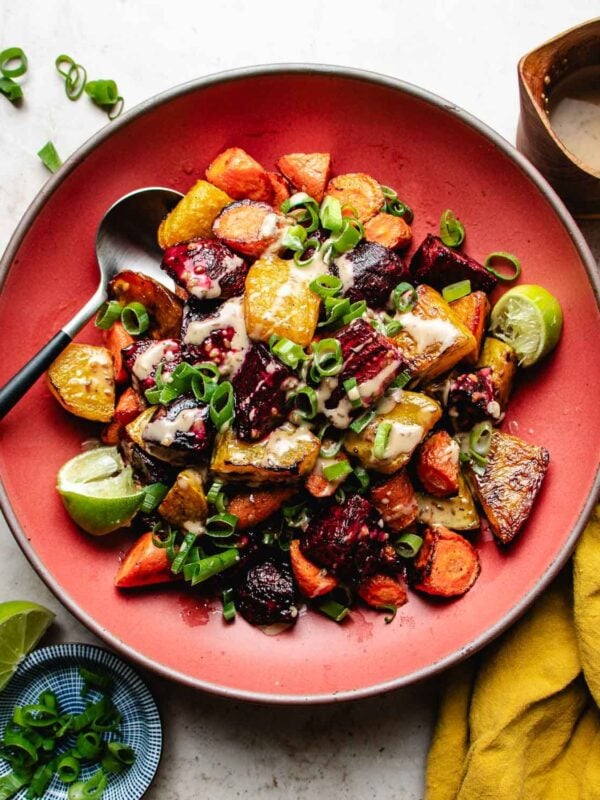
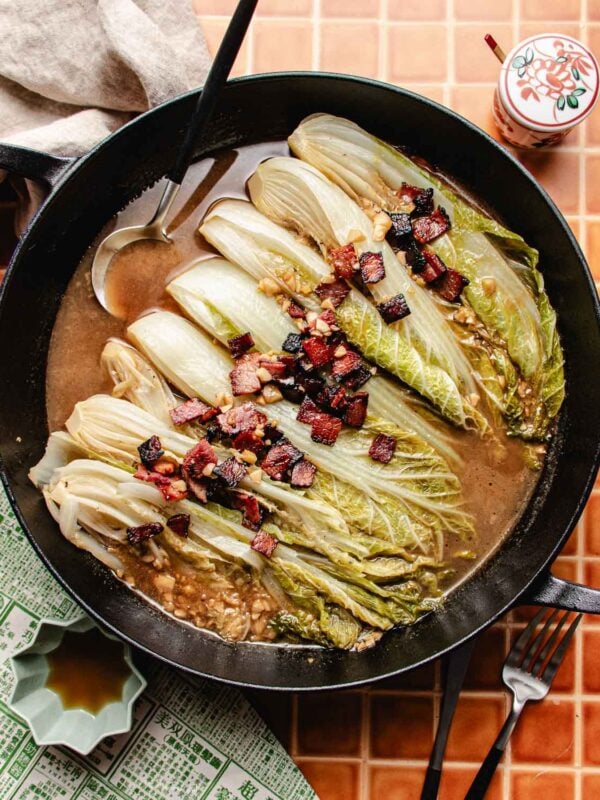
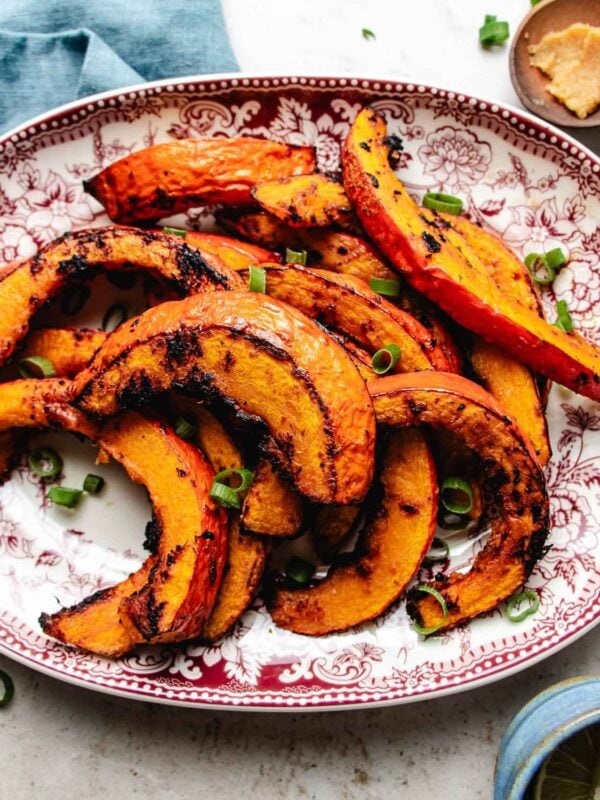










This turned out to be restaurant quality. I will definitely be using this recipe as my go-to again in the future.
I’m so happy to hear that. Thank you so much for making the dish, Sara. 🙂